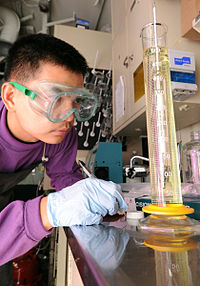
The impact of pollen consumption on honey bee (Apis mellifera) digestive physiology and carbohydrate metabolism.
Sign Up to like & getrecommendations! Published in 2017 at "Archives of insect biochemistry and physiology"
DOI: 10.1002/arch.21406
Abstract: Carbohydrate-active enzymes play an important role in the honey bee (Apis mellifera) due to its dietary specialization on plant-based nutrition. Secretory glycoside hydrolases (GHs) produced in worker head glands aid in the processing of floral… read more here.
Keywords: pollen consumption; physiology; honey; honey bee ... See more keywords

Gold Immunochromatographic Assay for Rapid On‐Site Detection of Lincosamide Residues in Milk, Egg, Beef, and Honey Samples
Sign Up to like & getrecommendations! Published in 2019 at "Biotechnology Journal"
DOI: 10.1002/biot.201900174
Abstract: Lincosamides (LMs), include clindamycin (CLIN), lincomycin (LIN), and pirlimycin (PIR), that are widely used as veterinary drugs. LM residues in edible animal origin foods endanger human health and are in urgent need of establishing fast,… read more here.
Keywords: beef honey; detection; honey; honey samples ... See more keywords

Plasticizing effect of Apis mellifera honey on whey protein isolate films
Sign Up to like & getrecommendations! Published in 2022 at "Biopolymers"
DOI: 10.1002/bip.23519
Abstract: The aims of this study were to analyze the plasticizing effect of Apis mellifera honey on the mechanical, physicochemical and optical properties of whey protein isolate (WPI) films and to compare the results collected with… read more here.
Keywords: wpi films; apis mellifera; honey; plasticizing effect ... See more keywords

Volume and density of microglomeruli in the honey bee mushroom bodies do not predict performance on a foraging task
Sign Up to like & getrecommendations! Published in 2017 at "Developmental Neurobiology"
DOI: 10.1002/dneu.22492
Abstract: The mushroom bodies (MBs) are insect brain regions important for sensory integration, learning, and memory. In adult worker honey bees (Apis mellifera), the volume of neuropil associated with the MBs is larger in experienced foragers… read more here.
Keywords: volume; honey; volume density; density ... See more keywords

Admixture in Africanized honey bees (Apis mellifera) from Panamá to San Diego, California (U.S.A.)
Sign Up to like & getrecommendations! Published in 2022 at "Ecology and Evolution"
DOI: 10.1002/ece3.8580
Abstract: Abstract The Africanized honey bee (AHB) is a New World amalgamation of several subspecies of the western honey bee (Apis mellifera), a diverse taxon historically grouped into four major biogeographic lineages: A (African), M (Western… read more here.
Keywords: honey; ancestry; admixture; honey bee ... See more keywords

Density of predating Asian hornets at hives disturbs the 3D flight performance of honey bees and decreases predation success
Sign Up to like & getrecommendations! Published in 2023 at "Ecology and Evolution"
DOI: 10.1002/ece3.9902
Abstract: Abstract Automated 3D image‐based tracking systems are new and promising devices to investigate the foraging behavior of flying animals with great accuracy and precision. 3D analyses can provide accurate assessments of flight performance in regard… read more here.
Keywords: predation success; honey bees; honey; flight ... See more keywords

Assessment of the vulnerability to pesticide exposures across bee species.
Sign Up to like & getrecommendations! Published in 2021 at "Environmental toxicology and chemistry"
DOI: 10.1002/etc.5150
Abstract: In many countries, the Western honey bee is used as surrogate in pesticide risk assessments for bees. However, uncertainty remains in the estimation of pesticide risk to non-Apis bees because their potential routes of exposure… read more here.
Keywords: vulnerability pesticide; honey; pesticide; bee species ... See more keywords

Acute Toxicity of Fungicide–Insecticide–Adjuvant Combinations Applied to Almonds During Bloom on Adult Honey Bees
Sign Up to like & getrecommendations! Published in 2022 at "Environmental Toxicology and Chemistry"
DOI: 10.1002/etc.5297
Abstract: Beekeepers report significant honey bee deaths during and after almond bloom. These losses pose a major problem for the California almond industry because of its dependence on honey bees as pollinators. The present study aimed… read more here.
Keywords: honey; toxicity; bloom; toxicology ... See more keywords

BeeGUTS—A Toxicokinetic–Toxicodynamic Model for the Interpretation and Integration of Acute and Chronic Honey Bee Tests
Sign Up to like & getrecommendations! Published in 2022 at "Environmental Toxicology and Chemistry"
DOI: 10.1002/etc.5423
Abstract: Understanding the survival of honey bees after pesticide exposure is key for environmental risk assessment. Currently, effects on adult honey bees are assessed by Organisation for Economic Co‐operation and Development standardized guidelines, such as the… read more here.
Keywords: toxicology; honey; honey bee; model ... See more keywords

Potential Risk of Residues From Neonicotinoid‐Treated Sugar Beet Flowering Weeds to Honey Bees (Apis mellifera L.)
Sign Up to like & getrecommendations! Published in 2023 at "Environmental Toxicology and Chemistry"
DOI: 10.1002/etc.5602
Abstract: In 2018 the European Union (EU) banned the three neonicotinoid insecticides imidacloprid, clothianidin (CLO), and thiamethoxam (TMX), but they can still be used if an EU Member State issues an emergency approval. Such an approval… read more here.
Keywords: toxicology; beet; honey; sugar beet ... See more keywords

Anatolian honey is not only sweet but can also protect from breast cancer: Elixir for women from artemis to present
Sign Up to like & getrecommendations! Published in 2017 at "IUBMB Life"
DOI: 10.1002/iub.1652
Abstract: Natural products with bioactive components are widely studied on various cancer cell lines for their possible cytotoxic effects, recently. Among these products, honey stands out as a valuable bee product containing many active phenolic compounds… read more here.
Keywords: cell lines; honey; breast cancer; cedar ... See more keywords